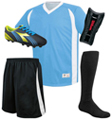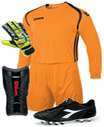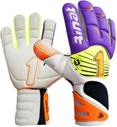Soccer Protective Gear FAQ
Soccer is a fun and fairly safe outdoor sport for all ages. As with any competitive team sport, it does carry risks and wearing soccer protective gear helps minimize those risks. When players are protected, their confidence improves. If you're new to soccer, or have a child just starting out, knowing what protective soccer gear he or she will be expected to wear can help make preparing for the upcoming season a little less daunting and a lot more enjoyable.
- What protective equipment do soccer players wear?
- What protective equipment do soccer goalies wear?
- Why don't soccer players wear helmets?
- What should I look for in good soccer goalie gloves?
- What kind of cleats do soccer players wear?
- Can I wear my baseball cleats for soccer?
- What kind of shin guards do soccer players wear?
- How do I wear my shin guards?
- Conclusion
 What protective equipment do soccer players wear?
What protective equipment do soccer players wear?
Basic soccer equipment consists soccer shirt or jersey, shorts, stockings, shin guards and shoes. FIFA provides no specific rules about protective gear; rules say that additional equipment may be worn as long as it doesn't pose a danger to players, however check with your local league. Extra protective gear may include sliding shorts, mouth guards, protective cups, knee and elbow pads, padded soccer pants, soccer gloves, and protective head gear.
"A player must not use equipment or wear anything that is dangerous to himself or another player (including any kind of jewelery)" --Rules of the Game, Law 4, The Players' Equipment
 What protective equipment do soccer goalies wear?
What protective equipment do soccer goalies wear?
Like their teammates, goalkeepers are required to wear the basics; jersey, shorts, socks, shin guards and cleats. There are a couple things unique to the soccer goalie. For one, his or her jersey will be a different color to distinguish them from their teammates. Secondly, considering the goalkeeper is the only one on their team allowed to handle a 'live' ball with their hands, they'll need a good pair of goalkeeper gloves. Some goalies wear approved caps to keep the sun out of their eyes, or goalie helmets for added safety. Rules say that any additional protection is fine, as long as it's related to the goalkeeper's function and is safe.
Why don't soccer players wear helmets?
This has long been a topic of debate in the soccer world. Although nothing specifically states in the laws that soccer players may not wear protective headgear, most choose not to because helmets interfere with heading the ball. Since soccer players are not allowed to use their hands, many passes are made using their heads - no pun intended! Yet, soccer carries a comparatively high risk of head injury from collision. According to the American Academy of Pediatrics, there's a much greater chance for getting a head injury from playing soccer than there is playing American football. Some soccer players, particularly those who have suffered a head injury in the past, have opted to wear some type of head gear, such as a skull cap, to give their noggins a little added insurance. To lessen the chances of injury, soccer trainers emphasize proper heading technique. Some youth soccer leagues have 'no heading' rules to minimize the risks.
 What should I look for in good soccer goalie gloves?
What should I look for in good soccer goalie gloves?
Though gloves are not a must in soccer, today's goalkeepers could not imagine defending their posts without them. The goalie is the one player whose hands are used in defense. A good pair of gloves is a goalkeeper's most valuable piece of equipment. Goalkeeper gloves are well-padded latex gloves featuring a tacky palm.
What to look for? Important elements to consider are fit, grip, design, features, and materials.
Fit. Wearing the correct size is key. Gloves should fit snug enough to allow goalies to catch and rebound the ball without the glove slipping, but not so tight as to cut off circulation. When trying on gloves, allow about a half-inch (thumbnail's width) between the fingertips and the glove. Goalkeeper gloves are sized numerically, starting with size 4 for kids, on up to size 12 for adults. Sizes differ slightly according to manufacturer. To be sure, measure your hand and follow the manufacturer's sizing guidelines. Your ultimate guarantee will be to try a pair on. If you're shopping online, try a few on in a store until you know the exact brand, model, and size you want. And then shop Epic Sports where you can save up to 60 percent off retail prices!
Grip. The palms of goalkeeper gloves are tacky for better contact with the ball. Palms can be either smooth or textured.
Design. Goalkeeper gloves range from flat to slightly rounded for comfort. Your choice.
Features. Things you'll consider when selecting a pair of gloves are ventilation, shock-aborption, durability, finger support, and construction.
Materials. Goalkeeper gloves are made from varying thicknesses of latex, most are between 3-4 mm. Contrary to intuition, quality does not mean durability when it comes to goalie gloves. While cheaper gloves may be more durable and last longer, they may not perform as well as a high-end pair of gloves made from sensitive latex. If you play under varying weather conditions and cannot afford more than one pair, you may want an all-weather glove.
What kind of cleats do soccer players wear?
Soccer involves a lot of footwork and running up and down the field. Soccer games can get pretty intense, and players are vulnerable to being jabbed in the ankles and shins by other players. Though FIFA safety rules don't specify that players wear a certain type of cleat.
Soccer shoes are specially designed for a soccer player's performance and safety on the field. Unlike other kinds of athletic field shoes, soccer cleats lack studs at the toe of the shoe. Soccer shoe designs also consider that athletes do a lot of passing with the sides, backs, and tops of feet, and that players need to 'feel' the ball with their feet more than other field athletes.
Soccer shoes are designed accordingly:
Features. Your feet spend a lot of time with the ball. In addition to providing traction, your soccer footwear should allow your feet to feel the ball. Look for soccer cleats that fit well, are lightweight and flexible, waterproof, and close securely.
Different kinds. There are a few types of soccer cleats, depending on the kind of surface you play on. Firm Ground cleats feature molded studs for use on hard surfaces, which is the most versatile and common choice. Soft Ground cleats are for loose or wet surfaces and feature longer and fewer studs, and are sometimes removable. Select your cleats by general soccer field conditions and local league requirements. Most soccer cleats are fine as long as the referee doesn't consider them dangerous.

Can I wear my baseball cleats for soccer?
No. Baseball cleats are specifically designed for baseball and feature a cleat on the front toe, which could be dangerous to other players. Soccer cleats are specially designed for the safety of soccer players. So while soccer cleats are generally okay for youth softball or baseball, baseball cleats are not allowed to be worn by soccer players.
What kind of shin guards do soccer players wear?

Soccer involves a lot of footwork and players run the risk of getting injured in the shins by other players. Soccer shin guards should provide full protection from the top of the cleat, NFHS rules say no more than two inches above, to just below the knees.
Laws of the Game, Law 4, states that approved soccer shin guards:
- Are entirely covered by the stockings
- Are made of rubber, plastic, or a similar suitable material
- Provide a reasonable degree of protection
Soccer athletes play more confidently and aggressively knowing they're not going to get jabbed in the shins or knocked in the head by a piece of equipment or another player. Since soccer isn't technically a contact sport, it's generally considered safe. But soccer does run its risks, which is part of what makes soccer not just fun but exciting too. Whether you're in it to win, or just enjoy its recreational benefits, there's no sense in risking an injury that could keep you out of the game permanently. So play hard but safe, and enjoy your soccer season!



